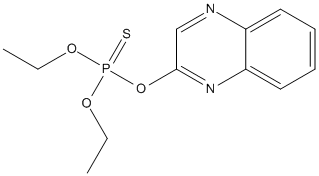Quinalphos
General
Type : Organophosphate,Quinoxaline,Insecticide,Sulfur Compound
Chemical_Nomenclature : diethoxy-quinoxalin-2-yloxy-sulfanylidene-$l^{5}-phosphane
Canonical SMILES : CCOP(=S)(OCC)OC1=NC2=CC=CC=C2N=C1
InChI : InChI=1S\/C12H15N2O3PS\/c1-3-15-18(19,16-4-2)17-12-9-13-10-7-5-6-8-11(10)14-12\/h5-9H,3-4H2,1-2H3
InChIKey : JYQUHIFYBATCCY-UHFFFAOYSA-N
Other name(s) : O,O-diethyl O-2-quinoxalinyl phosphorothioate,Diethquinalphion,Diethyl O-(2-quinoxalyl) phosphorothioate,Diethyl O-(quinoxalin-2-yl) thiophosphate,Diethyl O-2-quinoxalinyl phosphorothioate,Diethyl O-quinoxalin-2-yl thionophosphate,SRA 7312,Bayrusil,Ekalux,Wie oben
MW : 298.30
Formula : C12H15N2O3PS
CAS_number : 13593-03-8
PubChem : 26124
UniChem : JYQUHIFYBATCCY-UHFFFAOYSA-N
IUPHAR :
Wikipedia : Quinalphos

Target
References (4)
| Title : Role of cytochrome P-450 in quinalphos toxicity: effect on hepatic and brain antioxidant enzymes in rats - Dwivedi_1998_Food.Chem.Toxicol_36_437 |
| Author(s) : Dwivedi PD , Das M , Khanna SK |
| Ref : Food & Chemical Toxicology , 36 :437 , 1998 |
| Abstract : Dwivedi_1998_Food.Chem.Toxicol_36_437 |
| ESTHER : Dwivedi_1998_Food.Chem.Toxicol_36_437 |
| PubMedSearch : Dwivedi_1998_Food.Chem.Toxicol_36_437 |
| PubMedID: 9662419 |
| Title : Evaluation of organophosphorus pesticide residues in citrus fruits from the Valencian community (Spain) - Torres_1997_J.AOAC.Int_80_1122 |
| Author(s) : Torres CM , Pico Y , Marin R , Manes J |
| Ref : Journal of AOAC International , 80 :1122 , 1997 |
| Abstract : Torres_1997_J.AOAC.Int_80_1122 |
| ESTHER : Torres_1997_J.AOAC.Int_80_1122 |
| PubMedSearch : Torres_1997_J.AOAC.Int_80_1122 |
| PubMedID: 9325585 |
| Title : Selective, solid-matrix dispersion extraction of organophosphate pesticide residues from milk - Di Muccio_1996_J.Chromatogr.A_754_497 |
| Author(s) : Di Muccio A , Pelosi P , Camoni I , Attard Barbini D , Dommarco R , Generali T , Ausili A |
| Ref : Journal of Chromatography A , 754 :497 , 1996 |
| Abstract : Di Muccio_1996_J.Chromatogr.A_754_497 |
| ESTHER : Di Muccio_1996_J.Chromatogr.A_754_497 |
| PubMedSearch : Di Muccio_1996_J.Chromatogr.A_754_497 |
| PubMedID: 8997741 |
| Title : Urinary excretion of diethylphosphorus metabolites in persons poisoned by quinalphos or chlorpyrifos - Vasilic_1992_Arch.Environ.Contam.Toxicol_22_351 |
| Author(s) : Vasilic Z , Drevenkar V , Rumenjak V , Stengl B , Frobe Z |
| Ref : Archives of Environmental Contamination & Toxicology , 22 :351 , 1992 |
| Abstract : Vasilic_1992_Arch.Environ.Contam.Toxicol_22_351 |
| ESTHER : Vasilic_1992_Arch.Environ.Contam.Toxicol_22_351 |
| PubMedSearch : Vasilic_1992_Arch.Environ.Contam.Toxicol_22_351 |
| PubMedID: 1375016 |